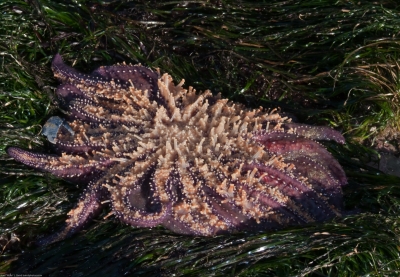 Sun Study: Sunflower sea star population in peril
Sun Study: Sunflower sea star population in peril
Kayla White, UHM MOP Student
A beautiful creature as big as a manhole cover was once abundant along the West Coast of North America. Now, the sunflower sea star (Pycnopodia helianthoides) can rarely be found in California coastal waters. Ocean acidification and infectious disease have wiped out populations from Southern California to Alaska and the effects of this disease are starting to spread to other trophic levels in the oceanic ecosystem.
Sea star wasting syndrome (SSWS) is a general description for many symptoms that take place in a sea star. Lesions appear in the ectoderm of the sea star and soon after, the tissue around these lesions starts to decay. This can lead to the eventual fragmentation of the body and then to death. Sea stars can look deflated as a symptom of the disease. When symptoms of SSWS start to show, it can be as short as a few days for a sea star to die.
Some species are bouncing back from the massive wipe-out events like the ochre star (Pisaster ochraceus), but others are not having as successful recoveries. Wildlife epidemiologist from UC Davis One Health Institute, Diego Montecino-Latoree, says, “This is likely because this disease has many hosts, and other species that tolerate the pathogen better may spread it to the sunflower star.”
Global warming due to atmospheric change is likely a factor of why this disease has spread so fast. “The heat wave in the oceans – a product of increasing atmospheric temperatures – is exacerbating the sea star wasting disease,” says Drew Harvell, a fellow at Cornell’s Atkinson Center for Sustainable Future. “It’s a lethal disease, and when you add a higher temperature to that, it kills faster, causing a bigger impact.”
Nearshore kelp forests form healthy environments for fish and other wildlife in the oceanic ecosystem. With a decline in sunflower sea stars, sea urchin (Echinoidea) populations have exploded which reduces kelp substantially.
The National Oceanic and Atmospheric Association (NOAA) surveyed sunflower sea stars in thousands of deep sites from the Canadian border to Mexico and found a 100 percent decline in all deep-water states down to 1,000 meters.
Scientists at the Ocean Conservancy say that in order to decrease the effects of sea star wasting disease, we must lower our carbon emissions fast. “A healthy ocean is only achievable if we confront the damage that carbon emissions are having on the world’s ocean now.”
 Read this issue on Issuu:
Read this issue on Issuu:
April 2019 XXXIII Seawords
